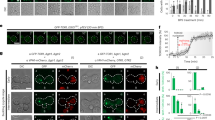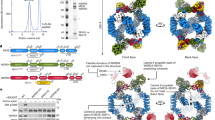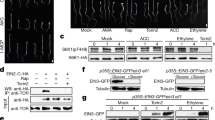Abstract
The rapamycin-sensitive TOR signalling pathway in Saccharomyces cerevisiae activates a cell-growth program in response to nutrients such as nitrogen and carbon1,2,3,4. The TOR1 and TOR2 kinases (TOR) control cytoplasmic protein synthesis and degradation through the conserved TAP42 protein5,6,7,8. Upon phosphorylation by TOR, TAP42 binds and possibly inhibits type 2A and type-2A-related phosphatases6,7,8; however, the mechanism by which TOR controls nuclear events such as global repression of starvation-specific transcription is unknown. Here we show that TOR prevents transcription of genes expressed upon nitrogen limitation by promoting the association of the GATA transcription factor GLN3 with the cytoplasmic protein URE2. The binding of GLN3 to URE2 requires TOR-dependent phosphorylation of GLN3. Phosphorylation and cytoplasmic retention of GLN3 are also dependent on the TOR effector TAP42, and are antagonized by the type-2A-related phosphatase SIT4. TOR inhibits expression of carbon-source-regulated genes by stimulating the binding of the transcriptional activators MSN2 and MSN4 to the cytoplasmic 14-3-3 protein BMH2. Thus, the TOR signalling pathway broadly controls nutrient metabolism by sequestering several transcription factors in the cytoplasm.
This is a preview of subscription content, access via your institution
Access options
Subscribe to this journal
Receive 51 print issues and online access
$199.00 per year
only $3.90 per issue
Buy this article
- Purchase on Springer Link
- Instant access to full article PDF
Prices may be subject to local taxes which are calculated during checkout





Similar content being viewed by others
References
Thomas,G. & Hall,M. N. TOR signalling and control of cell growth. Curr. Opin. Cell Biol. 9, 782–787 (1997).
Barbet,N. C. et al. TOR controls translation initiation and early G1 progression in yeast. Mol. Biol. Cell 7, 25–42 (1996).
Noda,T. & Ohsumi,Y. Tor, a phosphatidylinositol kinase homologue, controls autophagy in yeast. J. Biol. Chem. 273, 3963–3966 (1998).
Beck,T., Schmidt,A. & Hall,M. N. Starvation induces vacuolar targeting and degradation of the tryptophan permease in yeast. J. Cell Biol. 146, 1227–1237 (1999).
Dennis,P. B., Fumagalli,S. & Thomas,G. Target of rapamycin (TOR): balancing the opposing forces of protein synthesis and degradation. Curr. Opin. Genet. Dev. 9, 49–54 (1999).
Di Como,C. J. & Arndt,K. T. Nutrients, via the Tor proteins, stimulate the association of Tap42 with type 2A phosphatases. Genes Dev. 10, 1904–1916 (1996).
Schmidt,A., Beck,T., Koller,A., Kunz,J. & Hall,M. N. The TOR nutrient signalling pathway phosphorylates NPR1 and inhibits turnover of the tryptophan permease. EMBO J. 17, 6924–6931 (1998).
Jiang,Y. & Broach,J. R. Tor proteins and protein phosphatase 2A reciprocally regulate Tap42 in controlling cell growth in yeast. EMBO J. 18, 2782–2792 (1999).
Marzluf,G. A. Genetic regulation of nitrogen metabolism in the fungi. Microbiol. Mol. Biol. Rev. 61, 17–32 (1997).
Marini,A. M., Soussi-Boudekou,S., Vissers,S. & Andre,B. A family of ammonium transporters in Saccharomyces cerevisiae. Mol. Cell. Biol. 17, 4282–4293 (1997).
Magasanik,B. in The Molecular and Cellular Biology of the Yeast Saccharomyces (eds Jones, E. W., Pringe, J. R. & Broach, J. R.) 283–317 (Cold Spring Harbor Laboratory Press, New York, 1992).
Blinder,D., Coschigano,P. W. & Magasanik,B. Interaction of the GATA factor Gln3p with the nitrogen regulator Ure2p in Saccharomyces cerevisiae. J. Bacteriol. 178, 4734–4736 (1996).
Coschigano,P. W. & Magasanik,B. The URE2 gene product of Saccharomyces cerevisiae plays an important role in the cellular response to the nitrogen source and has homology to glutathione S-transferases. Mol. Cell. Biol. 11, 822–832 (1991).
Heitman,J., Movva,N. R. & Hall,M. N. Targets for cell cycle arrest by the immunosuppressant rapamycin in yeast. Science 253, 905–909 (1991).
Smith,A., Ward,M. P. & Garrett,S. Yeast PKA represses Msn2p/Msn4p-dependent gene expression to regulate growth, stress response and glycogen accumulation. EMBO J. 17, 3556–3564 (1998).
Gorner,W. et al. Nuclear localization of the C2H2 zinc finger protein MsN2p is regulated by stress and protein kinase A activity. Genes Dev. 12, 586–597 (1998).
Boy-Marcotte,E., Perrot,M., Bussereau,F., Boucherie,H. & Jacquet,M. Msn2p and Msn4p control a large number of genes induced at the diauxic transition which are repressed by cyclic AMP in Saccharomyces cerevisiae. J. Bacteriol. 180, 1044–1052 (1998).
Brunet,A. et al. Akt promotes cell survival by phosphorylating and inhibiting a Forkhead transcription factor. Cell 96, 857–868 (1999).
Bertram,P. G., Zeng,C., Thorson,J., Shaw,A. S. & Zheng,X. F. The 14-3-3 proteins positively regulate rapamycin-sensitive signaling. Curr. Biol. 8, 1259–1267 (1998).
Kops,G. J. et al. Direct control of the Forkhead transcription factor AFX by protein kinase B. Nature 398, 630–634 (1999).
Hara,K. et al. Amino acid sufficiency and mTOR regulate p70 S6 kinase and eIF-4E BP1 through a common effector mechanism. J. Biol. Chem. 273, 14484–14494 (1998); erratum, 22160 (1998).
Wach,A., Brachat,A., Pohlmann,R. & Philippsen,P. New heterologous modules for classical or PCR-based gene disruptions in Saccharomyces cerevisiae. Yeast 10, 1793–1808 (1994).
Longtine,M. S. et al. Additional modules for versatile and economical PCR-based gene deletion and modification in Saccharomyces cerevisiae. Yeast 14, 953–961 (1998).
Sherman,F. in Guide to Yeast Genetics and Molecular Biology (eds Guthrie, C. & Fink, G. R.) 3–21 (Academic, San Diego, 1991).
Ausubel,F. M. et al. (eds) Current Protocols in Molecular Biology (John Wiley & Sons, New York, 1998).
Acknowledgements
We thank T. W. Sturgill and T. Schmelzle for comments on the manuscript, E. Jacinto for unpublished results, and A. Löschmann for technical assistance. The work was supported by grants of the Swiss National Science Foundation and the Canton of Basel (M.N.H.).
Author information
Authors and Affiliations
Corresponding author
Rights and permissions
About this article
Cite this article
Beck, T., Hall, M. The TOR signalling pathway controls nuclear localization of nutrient-regulated transcription factors. Nature 402, 689–692 (1999). https://doi.org/10.1038/45287
Received:
Accepted:
Issue Date:
DOI: https://doi.org/10.1038/45287
This article is cited by
-
Aspergillus fumigatus escape mechanisms from its harsh survival environments
Applied Microbiology and Biotechnology (2024)
-
Autophagic chemicals effect for male-killing Wolbachia, Atg8 and TOR genes in Ostrinia scapulalis (Lepidoptera:Crambidae)
Applied Entomology and Zoology (2023)
-
Response mechanisms of Saccharomyces cerevisiae to the stress factors present in lignocellulose hydrolysate and strategies for constructing robust strains
Biotechnology for Biofuels and Bioproducts (2022)
-
Msn2/4 transcription factors positively regulate expression of Atg39 ER-phagy receptor
Scientific Reports (2021)
-
Investigating the role of the transcriptional regulator Ure2 on the metabolism of Saccharomyces cerevisiae: a multi-omics approach
Applied Microbiology and Biotechnology (2021)
Comments
By submitting a comment you agree to abide by our Terms and Community Guidelines. If you find something abusive or that does not comply with our terms or guidelines please flag it as inappropriate.



